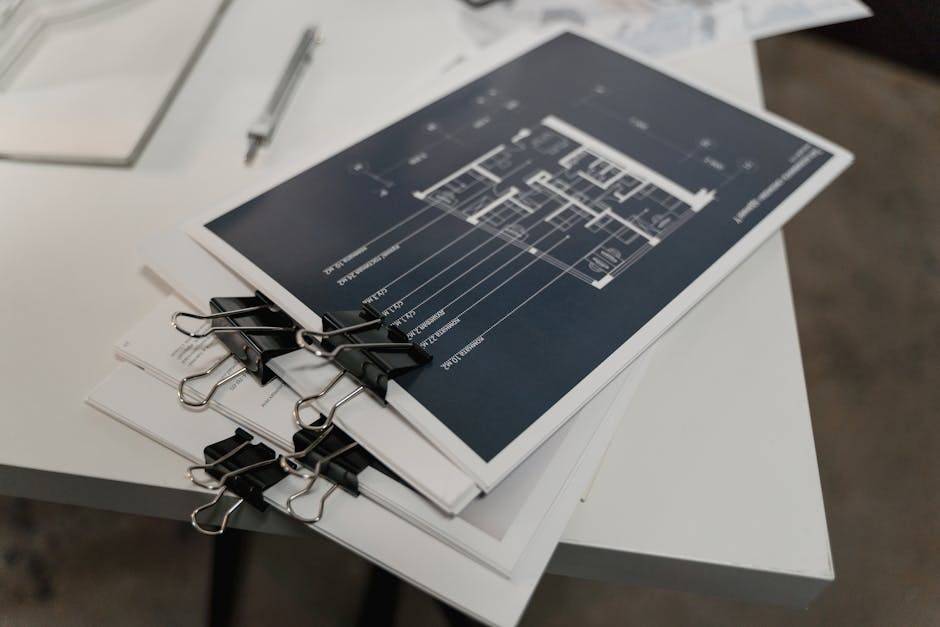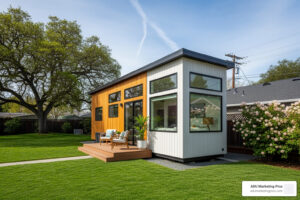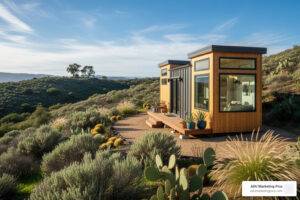Open uping the Potential of ADU Architectural Plans
ADU architectural plans are essential blueprints for creating a versatile and profitable living space right in your backyard. Whether you’re a homeowner thinking about adding extra space, or a builder specializing in these innovative units, understanding the core aspects of ADU plans is crucial.
- What is an ADU?
-
An Accessory Dwelling Unit (ADU) is a secondary living space on a primary residential lot. It can be a detached building, like a cottage, or a converted space within your home, such as a garage apartment.
-
Why are ADUs Popular?
-
With increasing housing shortages in urban areas and changes in zoning laws, ADUs have gained popularity as a flexible housing solution. ADUs provide additional income opportunities and can house family members or tenants while adding value to your property.
-
Benefits of ADUs:
- Income Generation: Rent out the space to earn additional income.
- Family Flexibility: Offer proximity living options for family, such as aging parents.
- Improved Property Value: ADUs increase the overall value of your property.
Navigating ADU architectural plans can open up new opportunities for living space and income, but the process can be complex due to local regulations. Understanding these plans and how they can be customized is key to maximizing their potential.

The Basics of ADU Architectural Plans
When diving into ADU architectural plans, understanding the essentials is key. These plans serve as the foundation for creating a functional and stylish additional living space on your property. Here, we’ll break down the core components: floor plans, design elements, and customization options.
ADU Floor Plans
At the heart of every successful ADU project is a well-thought-out floor plan. These plans outline the layout of the space, detailing the arrangement of rooms, the flow between areas, and the placement of key features like kitchens and bathrooms.
- Types of ADU Floor Plans:
- 1 Bedroom Plans: Ideal for individuals or couples, these plans typically range from compact layouts under 500 sqft to more spacious designs up to 1200 sqft.
- 2 Bedroom Plans: Perfect for small families or as rental units, providing more space and flexibility.
- Studio Plans: Efficient use of space, often under 500 sqft, suitable for single occupants or short-term rentals.
Each plan is designed to maximize space in smaller homes, ensuring that every square foot is used effectively.
ADU Design Elements
Design elements in ADU plans are crucial for ensuring both functionality and aesthetic appeal. These elements include the style of the unit, materials used, and the integration of modern amenities.
- Key Design Elements:
- Open Living Areas: Promotes a sense of space and light.
- Energy Efficiency: Incorporating features like energy-efficient windows and insulation.
- Modern Finishes: High-quality materials for a contemporary look.
By focusing on these elements, homeowners can ensure their ADU is not only functional but also attractive and comfortable.
ADU Customization
One of the greatest advantages of ADU architectural plans is the ability to customize. Whether you start with a pre-designed plan or opt for a fully custom design, tailoring the space to meet specific needs is possible.
- Customization Options:
- Layout Adjustments: Modify room sizes or add features like a kitchen island.
- Exterior Styles: Match the ADU with the main house or choose a contrasting design.
- Interior Details: Select finishes, fixtures, and appliances that suit your style.
For instance, a client in Vista, California, expanded a standard 1-bedroom ADU plan by adding 200 sqft, creating a more spacious living area and an eat-in kitchen island. This customization made the unit perfect for her adult daughter.
Customization allows homeowners to create an ADU that not only meets their practical needs but also aligns with their personal style and the architectural character of the main home.
Understanding these basics of ADU architectural plans can help you make informed decisions as you start on your ADU project. Up next, we’ll explore the costs associated with these projects and how to budget effectively.
Cost Considerations for ADU Projects
When planning an Accessory Dwelling Unit (ADU), understanding the costs involved is crucial. ADU construction costs can vary widely, influenced by factors like location, materials, and design complexity. Let’s break down these cost considerations to help you budget effectively.
ADU Construction Costs
The price tag for building an ADU can range significantly. In places like Portland, the estimated costs have historically fallen between $200,000 and $400,000. However, these numbers can climb even higher in cities like Seattle or Los Angeles due to fluctuating labor and material expenses.
- Factors Affecting Costs:
- Location: Costs can vary by city due to local labor rates and regulatory requirements.
- Design Complexity: More intricate designs or custom features can drive up costs.
- Materials: Choices between standard and premium materials affect the overall budget.

ADU Cost Variations
Cost variations arise not just from geographic differences but also from the type of ADU. Detached units generally cost more than attached ones due to additional infrastructure needs like separate utilities.
- Detached vs. Attached ADUs:
- Detached: Typically more expensive due to standalone construction and utilities.
- Attached: May leverage existing structures, reducing some costs.
ADU Budgeting
Effective budgeting is key to ensuring your ADU project stays on track financially. Here are some steps to help you manage your budget:
- Get Multiple Estimates: Consult with local contractors experienced in ADU projects to get accurate quotes.
- Plan for Contingencies: Set aside a contingency fund (typically 10-20% of the total budget) for unexpected expenses.
- Consider Long-term Value: An ADU can add property value and generate rental income, which can offset upfront costs over time.
By understanding these cost considerations, you can make informed decisions and develop a realistic budget for your ADU project. Up next, we’ll dig into the advantages and drawbacks of ADUs to help you weigh the benefits against potential challenges.
Advantages and Drawbacks of ADUs
Building an Accessory Dwelling Unit (ADU) can be a fantastic way to add value and functionality to your property. However, like any significant investment, it comes with its own set of advantages and drawbacks. Let’s explore these to help you decide if an ADU is the right choice for you.
ADU Benefits
-
Increased Property Value: An ADU can significantly boost your property’s overall value. Potential buyers often find the extra living space appealing, whether for family use or rental income. According to Investopedia, ADUs can attract buyers looking for flexible living options.
-
Rental Income: Renting out your ADU can provide a steady income stream. This can help offset the initial construction costs and even cover ongoing maintenance expenses.
-
Flexible Living Arrangements: ADUs offer versatile living solutions. They can serve as housing for elderly family members, adult children returning home, or even as guest accommodations.
-
Efficient Use of Space: ADUs make use of existing land, providing additional space without needing to expand the main home. This can be a great solution for homeowners in urban areas with limited space.
ADU Drawbacks
-
Construction Costs: Building an ADU can be costly. As noted in the research, costs can range from $200,000 to $400,000 or more, depending on location and design complexity. It’s essential to budget carefully and consider long-term returns.
-
Property Taxes: Adding an ADU might increase your property taxes. Since your property’s value rises with the addition of an ADU, your tax assessment might follow suit, as explained by Investopedia.
-
Maintenance and Upkeep: An ADU requires regular maintenance just like any other dwelling. This can include repairs, landscaping, and utility management, which can add to your monthly expenses.
-
Space Utilization: While ADUs make efficient use of land, they can also occupy space that might otherwise be used for other purposes, such as a garden or garage.
By weighing these ADU benefits and drawbacks, you can make an informed decision about whether building an ADU aligns with your goals and financial situation. Next, we’ll look into the different types of ADU architectural plans and how they cater to various needs.
Types of ADU Architectural Plans
When planning an Accessory Dwelling Unit (ADU), choosing the right ADU architectural plans is crucial. Let’s explore the types of plans available and how they can be customized to fit your needs.
Pre-designed ADU Plans
Pre-designed ADU plans are a popular choice for many homeowners. These plans are ready-made and offer a quick and cost-effective way to start your ADU project. By purchasing a pre-designed plan, you receive a comprehensive set of drawings, including floor plans, building elevations, and detailed sections. This approach can save you thousands of dollars and months of planning time.
These plans cater to a wide range of needs, from a cozy studio to a spacious two-bedroom unit. Whether you’re looking to create a rental space or a guest house, pre-designed plans provide a solid foundation to get your project moving quickly. However, keep in mind that while these plans offer convenience, they might require some adjustments to meet local building codes and regulations.
Custom ADU Designs
For those seeking a more personalized touch, custom ADU designs are the way to go. These designs allow you to work closely with architects and designers to create a plan that fits your specific requirements. Whether it’s incorporating unique architectural features or optimizing the layout for your property, custom designs offer unparalleled flexibility.
Custom ADU designs are ideal for homeowners with specific goals or challenging site conditions that pre-designed plans can’t accommodate. While this option may involve higher upfront costs and longer timelines, the result is a custom living space that perfectly matches your vision.
ADU Plan Customization
If you find a pre-designed plan that almost meets your needs, ADU plan customization offers a middle ground. This approach involves modifying an existing plan to better suit your preferences or local requirements. Common modifications include altering room sizes, changing the layout, or adding specific features like a larger kitchen or extra storage.
Customization allows you to benefit from the cost savings of a pre-designed plan while still achieving a degree of personalization. The cost of these modifications typically ranges from $5,000 to $15,000, depending on the complexity of the changes.
Choosing the right type of ADU architectural plan depends on your budget, timeline, and specific needs. Whether you opt for a pre-designed plan, a custom design, or a customized version of an existing plan, consider how each option aligns with your goals and local building requirements. Up next, we’ll tackle some frequently asked questions about ADU architectural plans to help clarify any uncertainties you might have.
Frequently Asked Questions about ADU Architectural Plans
How much are ADU architecture fees?
The cost of ADU architectural plans can vary based on several factors, including the complexity of the design and the level of customization you desire. For pre-designed plans, you might spend anywhere from a few hundred to a few thousand dollars. These plans include essential elements like floor plans and building elevations, offering a cost-effective way to kickstart your project.
If you need custom designs, expect to pay more. Custom ADU design costs can range from $5,000 to $15,000, depending on the scope of your modifications. This investment allows you to tailor the space to your specific needs and preferences, ensuring the final result perfectly fits your vision.
Is it cheaper to build an ADU or add an addition?
When comparing the costs of building an ADU versus adding an addition to your existing home, several factors come into play. Generally, constructing an ADU can be more cost-efficient than a home addition, especially if you opt for a pre-designed plan.
Building an ADU as a separate structure often involves fewer structural changes to your existing home, minimizing disruption and potential complications. However, ADUs do require separate utilities and infrastructure, which can add to the cost.
On the other hand, a home addition might increase your home’s square footage and potentially its value, but it often involves more extensive renovations, which can be more expensive and time-consuming.
What’s one drawback of an ADU?
While ADUs offer many benefits, including additional living space and potential rental income, they are not without drawbacks. One significant consideration is property taxes. Adding an ADU to your property can increase its assessed value, leading to higher property taxes.
Moreover, maintaining an ADU—especially if used as a rental—requires ongoing effort and expense. You’ll need to account for maintenance, utilities, and potential repairs, which can add up over time.
Understanding these potential drawbacks is crucial when considering an ADU, as they can impact both your short-term budget and long-term financial planning.
In the next section, we’ll explore the various advantages and challenges of ADUs in more detail, helping you weigh the pros and cons effectively.
Conclusion
The ADU market is experiencing significant growth, driven by increasing demand for additional living spaces and rental income opportunities. As more homeowners recognize the benefits of Accessory Dwelling Units, the need for effective marketing strategies becomes paramount.
ADU Marketing Pros specializes in providing custom marketing solutions that help ADU construction and architecture firms stand out. By focusing on expertise over price, we enable companies to attract high-quality leads and grow their revenue. Our approach leverages targeted SEO, PPC, and social media strategies to ensure that your firm is the first choice for homeowners seeking premium ADU projects.
Our team is dedicated to understanding the unique challenges faced by ADU businesses. We continuously conduct market research and use data-driven insights to adapt our services to evolving regulations and consumer behaviors. This agile approach allows us to rapidly test and refine marketing campaigns, driving measurable growth for our clients.
By partnering with ADU Marketing Pros, you’re choosing a strategic ally committed to enhancing your brand recognition and expanding your market reach. We aim to build a strong, recognizable brand identity for your firm in the competitive ADU landscape.
To learn more about how we can support your firm with specialized marketing solutions, visit our ADU marketing solutions page. Let’s work together to transform your ADU projects from concept to creation.





